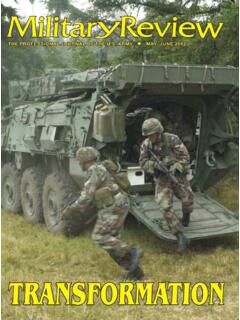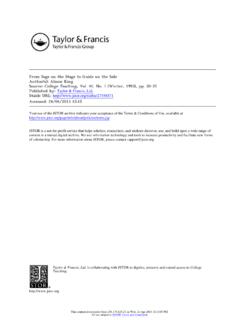Transcription of Mission Command: A Senior Enlisted Leader’s Perspective
1 NCO Journal1 May 2020 NCO Journal provides a forum and publishing opportunity for NCOs, by NCOs, for the open exchange of ideas and information in support of training, education and command : A Senior Enlisted Leader s PerspectiveMaster Sgt. Fred N. Army Sergeant Major AcademyAt the 2010 Joint Warfighting Conference, then-commander of Joint Forces command , retired Marine Corps Gen. James Mattis, caught the attention of Senior -level leaders by saying, I don t care how tactically or operationally brilliant you are, if you cannot create harmony on the battlefield based on trust across joint, interagency, intergovernmental, and multinational lines, you need to go home, because your leadership is obsolete (Luck, 2013, p. 10). Mattis was clear that military leaders should not base leadership proficiency solely on tactics and personal experience, but also on the ability to relay tactics and orders ac-curately to subordinates to be executed properly.
2 This builds trust that the commander s intent will be executed properly down the chain of command . The Army-wide philosophy of command and control is known as Mission command . This article analyzes the concepts of Mission command and uses contextual examples from the per-spective of a Senior command DefinedThe Department of the Army (2019b) defines Mission command as the Army s approach to command and control that empowers subordinate decision-making and decentralized execution appropriate to the situation (p. 1-3). Successful leaders understand the trust necessary for Mission command to take place. They balance com-mand and control by synchronizing processes and devel-oping plans with subordinates, allowing them to foster disciplined initiative (Department of the Army, 2019a). Army General Dwight D.
3 Eisenhower gives the order of the day to paratroopers in England, just before they board their airplanes to par-ticipate in the first assault in the invasion of the continent of Europe, June 5, 1944. (Photo courtesy of National Archives)NCO Journal2 May 2020 NCO Journal provides a forum and publishing opportunity for NCOs, by NCOs, for the open exchange of ideas and information in support of training, education and this to take place, Senior leaders must communicate clear intent down to the lowest level to allow a decentral-ized execution of of Mission CommandCommanders rely on the innovation and decisive action of subordinates to meet their intent in a complex operating environment. Commanders must be com-fortable accepting the inherent risks of operating in this manner (Department of the Army, 2019b).
4 According to Army Doctrine Publication (ADP) 6-0, Mission Com-mand: command and Control of Army Forces, command -ers and subordinates must build a relationship centered upon the seven principles of Mission command : Compe-tence, mutual trust, shared understanding , commander s intent, Mission orders, disciplined initiative, and risk acceptance (Department of the Army, 2019b, p. 1-7).CompetenceSoldiers should continually develop competence through institutional education, realistic training, and self-development. Organizations must also develop competence through realistic and complex collective unit training. Mutual trust and shared understanding between leaders and subordinates will grow once compe-tence is established (Department of the Army, 2019b).In November 1950 of the Korean War, the Eighth Army Rangers embodied this principle by trusting in one another and their training as they defended six consecutive attacks from Chinese forces on Hill 205.
5 The Rangers, led by1st Lt. Ralph Puckett, trusted in the spe-cific and realistic training they received (Piasecki, 2010). When asked about that night, now retired Col. Puckett said, we had the confidence that came from believing that we were the best that the United States of America could produce (Piasecki, 2010, para. 14).Mutual TrustAccording to ADP 6-0, Mutual trust is shared confidence between commanders, subordinates, and partners that they can be relied upon and are competent in performing their assigned tasks (Department of the Army, 2019b, ). Trust allows leaders to focus on the big picture instead of individual units or 75th Ranger Regiment is a prime example of mutual trust. New Rangers arrive at the organization with a foundation of tactical and technical competence and team leaders trust the assessment and selection process (Department of the Army, ).
6 This builds a shared trust as new Rangers arrive and develop within the UnderstandingThe foundation for creating shared understanding is built into Army doctrine, institutional training, Army culture, and a professional lexicon (Department of the Army, 2019b). This foundation promotes shared under-standing by keeping Soldiers informed throughout the operations process and collaborating whenever possible. Whether in garrison, or preparing for combat, the Army presents opportunities for leaders to practice effective communication and increase overall participation. This solidifies shared understanding of unit vision, values, commander s intent, and Mission 2014, the 1st Infantry Division (1ID) learned first-hand the challenges in creating shared understanding without a foundation. Working with Iraqi and coalition partners introduced challenges in language, communica-tion systems, and collaboration.
7 The 1ID overcame these obstacles by establishing a Combined Operations Center to alleviate the strain of incompatible communications systems. This resulted in increased collaboration between forces and 1ID conducting hundreds of successful coalition and joint strikes in support of Iraqi operations (Lemay, 2016).Commander s IntentThe commander is responsible for clearly commu-nicating his or her intent down to the lowest level. The intent must articulate the purpose of the Mission and desired end state (Department of the Army, 2019b). A common saying in the military is that no plan survives first contact with the enemy (Oxford University Press, ). A clearly articulated commander s intent allows leaders at all levels to continually adjust plans after first contact because every Soldier understands why they are doing the Mission and what the commander personal experience, as a reconnaissance team sergeant, every contingency plan has to align with the commander s intent.
8 Reconnaissance teams experience a wide array of challenges and obstacles during every oper-ation. With few teammates, and hundreds of kilometers ( Air Force photo by Master Sgt. Andy M. Kin taken June 4, 2019) A Army Ranger assigned to the 75th Ranger Regiment, conducts a Mission brief prior to climbing the cliffs at Pointe du Hoc, Cricque-ville en Bessin, France, June 4, Journal3 May 2020 NCO Journal provides a forum and publishing opportunity for NCOs, by NCOs, for the open exchange of ideas and information in support of training, education and the team and friendly forces, the commander s intent keeps the team grounded in achieving the Mission end state, regardless of the OrdersThe unit staff should construct Mission orders describing the situation, commander s intent, desired re-sults, and required subordinate tasks.
9 The commander s intent and Mission orders serve as the guide for subor-dinates to execute disciplined initiative. The staff must take care not to specify exactly how subordinates are to accomplish the tasks. This maximizes their freedom of action and creativity (Department of the Army, 2019b).Former Gen. of the Army Dwight Eisenhower s plan for Operation Overlord (the successful invasion of Normandy during World War II) is a prime example of a well-crafted commander s intent and Mission order. Authors Stephen Seitz et al., (2002) stated, Despite the magnitude of Overlord and the numerous tacti-cal operations required, the commander s intent was clear, simple, and succinct. understanding conveyed to subordinates enabled confidence, encouraged freedom of maneuver, and was the key to both operational and tactical success (p.)
10 4).Disciplined InitiativeAccording to the Department of the Army (2019b), there are two considerations subordinate leaders must evaluate before deciding to execute disciplined initiative: whether the benefits of the action outweigh the risk of desynchronizing the overall operation and whether the action will further the commander s intent (p. 1-12). Ex-perienced leaders understand the importance of exercising disciplined initiative because failing to do so can be 2005, a team of Navy SEALs realized the seri-ousness of their decisions while conducting a recon-naissance Mission in support of Operation Red Wings in eastern Afghanistan. The team experienced a soft compromise from local goat herders after insertion but did not move from their surveillance positions. This decision, which risked desynchronizing the operation before the assault force conducted the infiltration, failed to further the commander s intent.
















